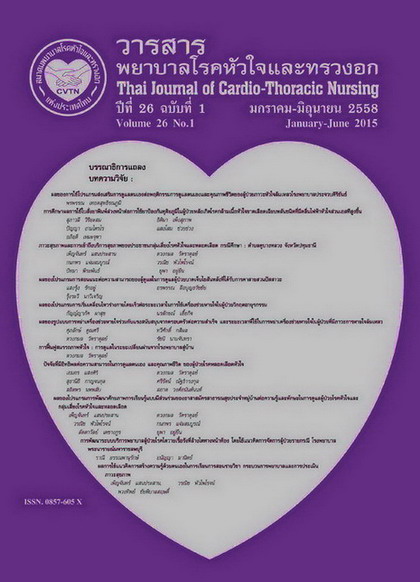การศึกษาผลการใช้ใบสั่งยาพิมพ์ล่วงหน้าต่อการใช้ยาป้องกัน ทุติยภูมิในผู้ป่วยหลังเกิดโรคกล้ามเนื้อหัวใจขาดเลือดเฉียบพลัน ชนิดที่มีคลื่นไฟฟ้าหัวใจส่วนเอสทีสูงขึ้น
คำสำคัญ:
ใบสั่งยาพิมพ์ล่วงหน้า, การป้องกันการกลับเป็นซ้ำ, กล้ามเนื้อหัวใจขาดเลือดเฉียบพลันชนิดที่มีคลื่นไฟฟ้าหัวใจส่วนเอสทีสูงขึ้นบทคัดย่อ
การศึกษานี้เป็นการเปรียบเทียบผลการใช้ใบสั่งยาพิมพ์ล่วงหน้าในผู้ป่วย หลังเกิดโรคกล้ามเนื้อหัวใจขาดเลือดเฉียบพลันชนิดที่มีคลื่นไฟฟ้าหัวใจส่วน เอสทีสูงขึ้น (post-STEMI) เพื่อศึกษาอัตราการสั่งใช้ยาป้องกันทุติยภูมิ 4 กลุ่ม ได้แก่ Antiplatelets (Aspirin และ/หรือ Clopidogrel), Beta blockers, Angiotensin Converting Enzyme Inhibitors (ACEIs) หรือ Angiotensin Receptor Blockers (ARBs) และ Statins พัฒนาและใช้ใบสั่งยาพิมพ์ล่วงหน้าให้สอดคล้องกับเกณฑ์ข้อบ่งชี้ของการใช้ยาป้องกันทุติยภูมิตามแนวทางของวิทยาลัยแพทย์โรคหัวใจและสมาคมหัวใจสหรัฐอเมริกา (ACC/AHA) และวัดผลลัพธ์อัตราการกลับเข้ารับการรักษาในโรงพยาบาล ภายใน 30 วัน
ผลการศึกษาพบว่าอัตราการสั่งใช้ยาป้องกันทุติยภูมิ 4 กลุ่มทั้งที่จุดสั่งยาผู้ป่วยกลับบ้านและที่จุดติดตามผู้ป่วยที่กลับมาพบแพทย์ตามนัดหมายภายใน 21 วันในผู้ป่วยที่ใช้ใบสั่งยาพิมพ์ล่วงหน้าสูงขึ้นกว่ากลุ่มที่ไม่ได้รับใบสั่งยาล่วงหน้าอย่างมีนัยสำคัญทางสถิติ (P<0.05) แต่อัตราการสั่งใช้ Antiplatelets, Beta blockers และ Statins ที่จุดสั่งยาผู้ป่วยกลับบ้าน และที่จุดติดตามผู้ป่วยภายใน 21 วัน ไม่แตกต่างกันอย่างมีนัยสำคัญทางสถิติ (p>0.05) ส่วนอัตราการสั่งใช้ ACEIs/ARBs เพิ่มขึ้นที่จุดสั่งยาผู้ป่วยกลับบ้าน และเพิ่มขึ้นที่จุดติดตามผู้ป่วย ภายใน 21 วัน ซึ่งแตกต่างกันอย่างมีนัยสำคัญทางสถิติ (P<0.05) ส่วนอัตราการกลับเข้ารับการรักษาในโรงพยาบาลภายใน 30 วัน ซึ่งเป็นตัวชี้วัดในการดูแลผู้ป่วย post-STEMI ในกลุ่มผู้ป่วยที่ใช้และไม่ใช้ใบสั่งยาพิมพ์ล่วงหน้ามีจำนวน 2 ราย และ 5 ราย ตามลำดับ ซึ่งไม่แตกต่างกันอย่างมีนัยสำคัญทางสถิติ (P=0.44) ส่วนสาเหตุของการกลับเข้ารับการรักษาในโรงพยาบาลคือผู้ป่วยมีภาวะ unstable angina และ heart failure ถึงแม้ว่าผู้ป่วยจะได้รับยาป้องกันทุติยภูมิครบ 4 กลุ่มแล้วแต่มีสาเหตุอื่นที่เกี่ยวข้องทำให้ผู้ป่วยจำเป็นต้องเข้ารับการ รักษาในโรงพยาบาลภายใน 30 วัน เช่น ตำแหน่งการเกิดกล้ามเนื้อหัวใจขาดเลือดเป็นบริเวณกว้างในส่วน anterior wall หรือผู้ป่วยเคยมีภาวะ cardiogenic shock หรือภาวะหัวใจล้มเหลว
การศึกษานี้ สามารถนำผลการวิจัยไปใช้ในการเพิ่มบทบาทของเภสัชกรในการส่งต่อเหตุผลการไม่สั่งใช้ยา Beta blockers และ ACEIs/ARBs เพื่อให้ผู้ป่วยโรคหัวใจได้รับการติดตามการรักษาและดูแลอย่างต่อเนื่อง
Effects of pre-printed order on the use of secondary prevention drug therapy In patients with post ST-Elevation Acute Myocardial Infarction
This was a comparative study about the effects of pre-printed order in patients with post ST-Elevation Acute Myocardial Infarction (post STEMI) on the prescription rate of 4 groups of secondary preventiondrugs including Antiplatelets (Aspirin and/or Clopidogrel), Beta blockers, Angiotensin Converting Enzyme Inhibitors (ACEIs) or Angiotensin Receptor Blockers (ARBs) and Statins. Pre-printed order form was developed and used according to the recommendation of American College of Cardiology and the American Heart Association (ACC/AHA) and the readmission within 30 days.
The results of the study demonstrated that the prescription rate of all 4 groups of secondary prevention drugs in patient with pre-printed order group at discharge site and follow up site were higher than in patient without pre-printed order group, which were statistically significant (p<0.05). However, there were no statistically significant difference between the prescription rate at discharge site of Antiplatelets, Beta blockers and Statins at follow up site and in patient with and without pre-printed order groups, which were not statistically significant different. The prescription rate of ACEIs/ARBs was significantly increased at discharge site and at follow up site (p<0.05). Moreover, readmission with in 30 days is one of quality indicator for post STEMI care. There were 2 cases in patient with pre-printed order group and 5 cases in patient without pre-printed order group, which were not statistically significant(p>0.05). They readmitted within 30 days due to unstable angina and congestive heart failure. Although post STEMI patients have received 4 secondary prevention drugs, there were other factors for readmission involved; i.e. extensive area of infarction at anterior wall or severity of clinical symptoms with cardiogenic shock and heart failure.
This study should be applied as pharmacist role to transmit the reason for not prescribing Beta blockers and ACEIs/ARBs in patients with heart disease at discharge site to follow up and provide continuing care.
ดาวน์โหลด
รูปแบบการอ้างอิง
ฉบับ
ประเภทบทความ
สัญญาอนุญาต
บทความนี้ยังไม่เคยตีพิมพ์หรืออยู่ในระหว่างส่งไปตีพิมพ์ในวารสารอื่น ๆ มาก่อน และกองบรรณาธิการขอสงวนสิทธิ์ในการตรวจทาน และแก้ไขต้นฉบับตามเกณฑ์ของวารสาร ในกรณีที่เรื่องของท่านได้ได้รับการตีพิมพ์ในวารสารฉบับนี้ถือว่าเป็น ลิขสิทธิ์ของวารสารพยาบาลโรคหัวใจและทรวงอก






